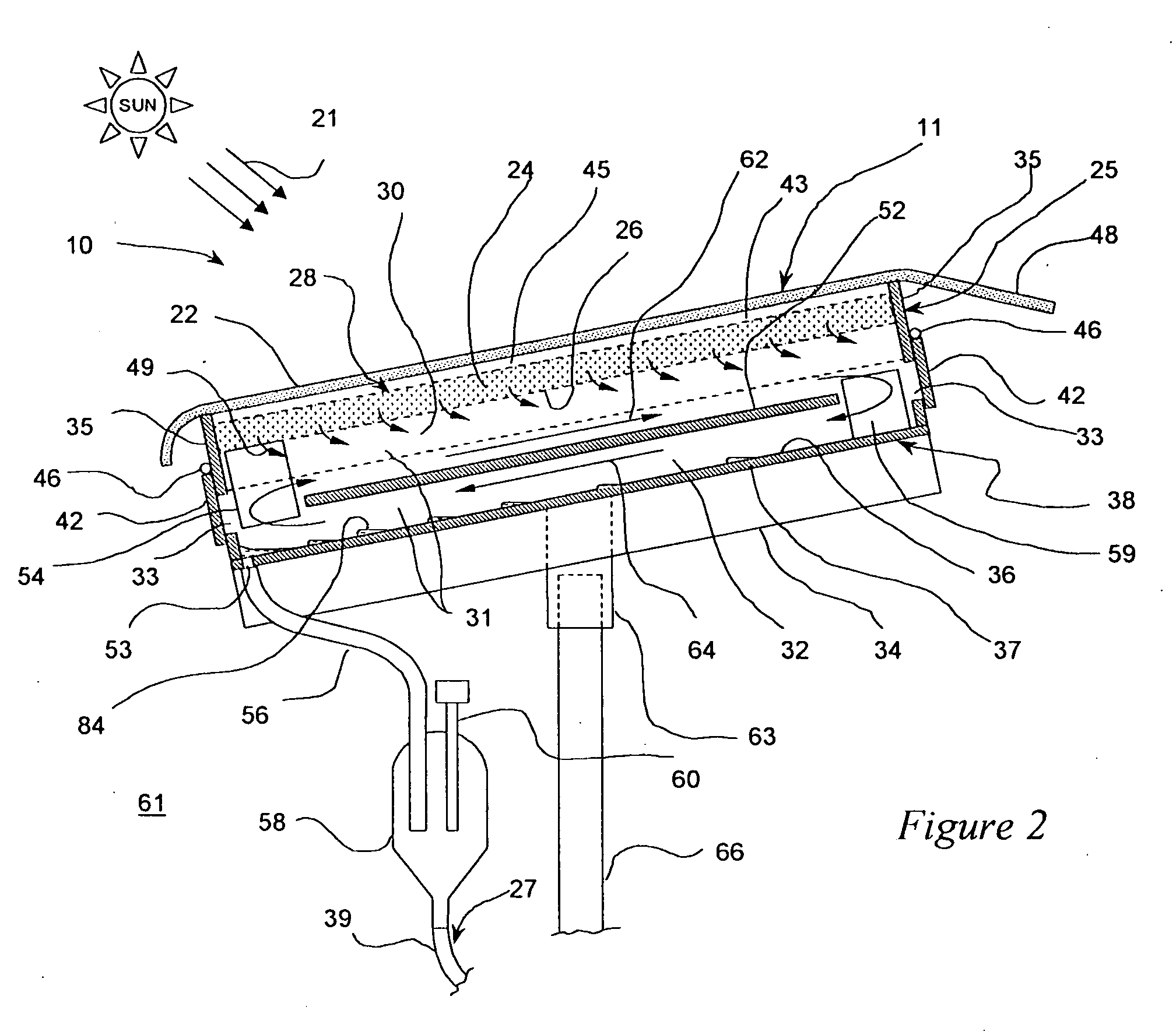Autonomous water source
a water source and autonomous technology, applied in the direction of domestic cooling apparatus, container discharge methods, separation processes, etc., can solve the problems of reducing crop yield and quality, affecting crop production, and affecting crop production, etc., and achieves the effect of simple and rugged
- Summary
- Abstract
- Description
- Claims
- Application Information
AI Technical Summary
Benefits of technology
Problems solved by technology
Method used
Image
Examples
example 1
[0080] A tray about 350 square centimeters in area with top and bottom walls made of aluminum wire mesh (0.010″ diameter, 15 mesh, about 73% open) weighing 155 grams is filled 733 grams of dry synthetic zeolite 3A, ⅛″ grain size, manufactured by Zeochem®, Louisville, Ky. The bottom of the tray is formed into V-shaped undulations approximately 1″, deep and 1″ wide. The top layer of zeolite is dyed black using #15 black aqueous dye manufactured by Bestfoods Specialty Products, Indianapolis, Ind. The zeolite is previously subjected to repeated (about 30) adsorption and desorption cycles. After completing the last desorption cycle, the tray weight was 1029 grams, indicating that 141 grams of water was contained in the zeolite (i.e., 19% of dry zeolite weight). The tray is covered with polyethylene film about 0.010″ in thickness, elevated at 15 degrees above horizon, and exposed to ambient air at night. (It should be noted that polyethylene has a good transmission properties at thermal r...
example 2
[0088] Consider an automatic watering system generally conforming to the first embodiment of the invention using 1 kg of type 3A synthetic zeolite sorption material. FIG. 5 shows the isotherms for zeolite 3A manufactured by Zeochem®, Louisville, Ky., showing the amount of water held by the zeolite as a function of partial pressure of water vapor for several zeolite temperatures. It can be readily noted that a given constant temperature, a reduction in partial pressure of water vapor corresponds to a reduction in the water content in the zeolite, and visa versa.
[0089] Consider the nighttime conditions with ambient air temperature 15 degrees Centigrade and a dew point 10 degrees Centigrade. The latter corresponds to about 10 Torr partial pressure of water vapor. After appropriately long exposure the zeolite too be eventually cool down to about 15 degrees Centigrade and adsorb water vapor from surrounding air to correspond to 22% of its dry weight, or 220 grams. This condition is labe...
example 3
[0092] A tray already described in Example 1 was exposed to still air at about 15 degrees Centigrade and about 40-60% humidity at night. In the morning the tray weight is 1046 grams, indicating 158 grams of water content. Subsequently, the tray is incorporated into a test apparatus generally corresponding to the first embodiment of subject invention shown in FIG. 1 through 4, and exposed to sunlight in the period between 10 am and 5 pm. Peak daytime temperature was 31 degrees Centigrade. At the end of this period, 24 grams of water condensate were collected in an external reservoir, which corresponds to about 3% of dry zeolite weight.
[0093] There are numerous variants to the invention and its components. FIG. 6 shows a tray 128 which is a variant to tray 28. Tray cover of tray 128 is a heat transfer element (HTE) 145, which collects solar radiation 21 and conducts it to sorption medium 24. HTE 145 is opaque in the solar radiation band and is preferably made of thermally conducting ...
PUM
| Property | Measurement | Unit |
|---|---|---|
| grain sizes | aaaaa | aaaaa |
| phase transition temperature | aaaaa | aaaaa |
| width | aaaaa | aaaaa |
Abstract
Description
Claims
Application Information
 Login to View More
Login to View More - R&D
- Intellectual Property
- Life Sciences
- Materials
- Tech Scout
- Unparalleled Data Quality
- Higher Quality Content
- 60% Fewer Hallucinations
Browse by: Latest US Patents, China's latest patents, Technical Efficacy Thesaurus, Application Domain, Technology Topic, Popular Technical Reports.
© 2025 PatSnap. All rights reserved.Legal|Privacy policy|Modern Slavery Act Transparency Statement|Sitemap|About US| Contact US: help@patsnap.com



